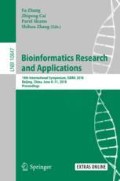Abstract
Given one generic linear genome \(\mathcal{G}\) with gene duplications (over n gene families), an exemplar genome G is a permutation obtained from \(\mathcal{G}\) by deleting duplicated genes such that G contains exactly one gene from each gene family (i.e., G is a permutation of length n). If we relax the constraint such that \(G^{+}\) is obtained in the same way but has length at least k, then we call \(G^{+}\) a pseudo-exemplar genome. Given \(\mathcal{G}\) and one exemplar genome H over the same set of n gene families, the One-sided Exemplar Adjacency Number problem (One-sided EAN) is defined as follows: delete duplicated genes from the genome \(\mathcal{G}\) to obtain an exemplar genome G of length n, such that the number of adjacencies between G and H is maximized. It is known that the problem is NP-hard; in fact, almost as hard to approximate as Independent Set, even when each gene (from the same gene family) appears at most twice in the generic genome \(\mathcal{G}\). To overcome the constraint on the length of G, we define a slightly more general problem (One-sided EAN+) where we only need to obtain a pseudo-exemplar genome \(G^{+}\) from \(\mathcal{G}\) (by deleting duplicated genes) such that the number of adjacencies in H and \(G^{+}\) is maximized. While One-sided EAN+ contains One-sided EAN as a special case, it does give us some flexibility in designing an algorithm. Firstly, we reformulate and relax the One-sided EAN+ problem as the maximum independent set (MIS) on a colored interval graph and hence reduce the appearance of each gene to at most two times. We show that this new relaxation is still NP-complete, though a simple factor-2 approximation algorithm can be designed; moreover, we also prove that the problem cannot be approximated within \(2-\varepsilon \) by a local search technique. Secondly, we use integer linear programming (ILP) to solve this relaxed problem exactly. Finally, we compare our results with the up-to-date software GREDU, with various simulation data. It turns out that our algorithm is more stable and can process genomes of length up to 12,000 (while GREDU sometimes can falter on such a large dataset).
Access this chapter
Tax calculation will be finalised at checkout
Purchases are for personal use only
References
Angibaud, S., Fertin, G., Rusu, I., Vialette, S.: A pseudo-boolean framework for computing rearrangement distances between genomes with duplicates. J. Comput. Biol. 14(4), 379–393 (2007)
Blin, G., Fertin, G., Sikora, F., Vialette, S.: The ExemplarBreakpointDistance for non-trivial genomes cannot be approximated. In: Das, S., Uehara, R. (eds.) WALCOM 2009. LNCS, vol. 5431, pp. 357–368. Springer, Heidelberg (2009). https://doi.org/10.1007/978-3-642-00202-1_31
Bryant, D.: The complexity of calculating exemplar distances. In: Sankoff, D., Nadeau, J. (eds.) Comparative Genomics: Empirical and Analytical Approaches to Gene Order Dynamics, Map Alignment, and the Evolution of Gene Families, pp. 207–212. Kluwer Academic Publishers, Dordrecht (2000)
Chen, Z., Fu, B., Zhu, B.: The approximability of the exemplar breakpoint distance problem. In: Cheng, S.-W., Poon, C.K. (eds.) AAIM 2006. LNCS, vol. 4041, pp. 291–302. Springer, Heidelberg (2006). https://doi.org/10.1007/11775096_27
Chen, Z., et al.: Non-breaking similarity of genomes with gene repetitions. In: Ma, B., Zhang, K. (eds.) CPM 2007. LNCS, vol. 4580, pp. 119–130. Springer, Heidelberg (2007). https://doi.org/10.1007/978-3-540-73437-6_14
Chen, Z., Fu, B., Goebel, R., Lin, G., Tong, W., Xu, J., Yang, B., Zhao, Z., Zhu, B.: On the approximability of the exemplar adjacency number problem of genomes with gene repetitions. Theor. Comput. Sci. 550, 59–65 (2014)
Gavril, F.: Algorithms for minimum coloring, maximum clique, minimum covering by cliques, and maximum independent set of a chordal graph. SIAM J. Comput. 1, 180–187 (1972)
Jiang, M.: The zero exemplar distance problem. J. Comput. Biol. 18(9), 1077–1086 (2011)
Nguyen, C.T., Tay, Y.C., Zhang, L.: Divide-and-conquer approach for the exemplar breakpoint distance. Bioinformatics 21(10), 2171–2176 (2005)
Sankoff, D.: Genome rearrangement with gene families. Bioinformatics 15(11), 909–917 (1999)
Shao, M., Moret, B.: A fast and exact algorithm for the exemplar breakpoint distance. J. Comput. Biol. 23(5), 337–346 (2016)
Acknowledgments
This research is partially supported by NSF of China (No. 61628027), and by NSF (CNS-1644348).
Author information
Authors and Affiliations
Corresponding author
Editor information
Editors and Affiliations
Rights and permissions
Copyright information
© 2018 Springer International Publishing AG, part of Springer Nature
About this paper
Cite this paper
Qingge, L., Smith, K., Jungst, S., Zhu, B. (2018). On Approaching the One-Sided Exemplar Adjacency Number Problem. In: Zhang, F., Cai, Z., Skums, P., Zhang, S. (eds) Bioinformatics Research and Applications. ISBRA 2018. Lecture Notes in Computer Science(), vol 10847. Springer, Cham. https://doi.org/10.1007/978-3-319-94968-0_27
Download citation
DOI: https://doi.org/10.1007/978-3-319-94968-0_27
Published:
Publisher Name: Springer, Cham
Print ISBN: 978-3-319-94967-3
Online ISBN: 978-3-319-94968-0
eBook Packages: Computer ScienceComputer Science (R0)

